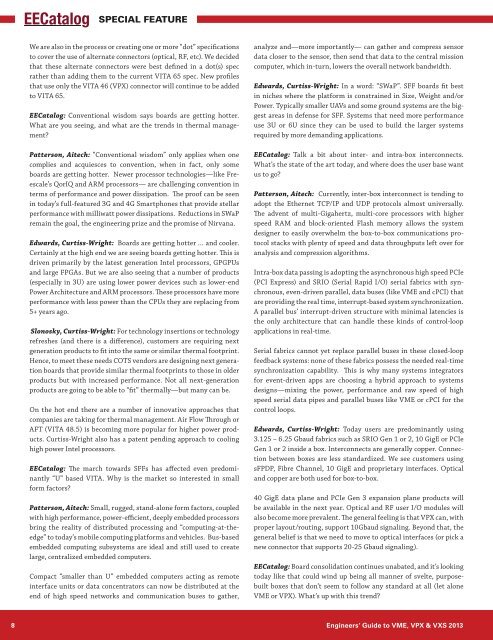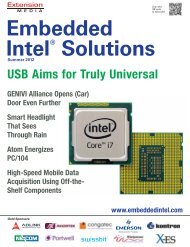the Engineers' Guide to VME, VPX & VXS 2013 - Subscribe
the Engineers' Guide to VME, VPX & VXS 2013 - Subscribe
the Engineers' Guide to VME, VPX & VXS 2013 - Subscribe
Create successful ePaper yourself
Turn your PDF publications into a flip-book with our unique Google optimized e-Paper software.
SPECIAL FEATURE<br />
We are also in <strong>the</strong> process or creating one or more “dot” specifications<br />
<strong>to</strong> cover <strong>the</strong> use of alternate connec<strong>to</strong>rs (optical, RF, etc). We decided<br />
that <strong>the</strong>se alternate connec<strong>to</strong>rs were best defined in a dot(s) spec<br />
ra<strong>the</strong>r than adding <strong>the</strong>m <strong>to</strong> <strong>the</strong> current VITA 65 spec. New profiles<br />
that use only <strong>the</strong> VITA 46 (<strong>VPX</strong>) connec<strong>to</strong>r will continue <strong>to</strong> be added<br />
<strong>to</strong> VITA 65.<br />
EECatalog: Conventional wisdom says boards are getting hotter.<br />
What are you seeing, and what are <strong>the</strong> trends in <strong>the</strong>rmal management?<br />
Patterson, Aitech: “Conventional wisdom” only applies when one<br />
complies and acquiesces <strong>to</strong> convention, when in fact, only some<br />
boards are getting hotter. Newer processor technologies—like Freescale’s<br />
QorIQ and ARM processors— are challenging convention in<br />
terms of performance and power dissipation. The proof can be seen<br />
in <strong>to</strong>day’s full-featured 3G and 4G Smartphones that provide stellar<br />
performance with milliwatt power dissipations. Reductions in SWaP<br />
remain <strong>the</strong> goal, <strong>the</strong> engineering prize and <strong>the</strong> promise of Nirvana.<br />
Edwards, Curtiss-Wright: Boards are getting hotter … and cooler.<br />
Certainly at <strong>the</strong> high end we are seeing boards getting hotter. This is<br />
driven primarily by <strong>the</strong> latest generation Intel processors, GPGPUs<br />
and large FPGAs. But we are also seeing that a number of products<br />
(especially in 3U) are using lower power devices such as lower-end<br />
Power Architecture and ARM processors. These processors have more<br />
performance with less power than <strong>the</strong> CPUs <strong>the</strong>y are replacing from<br />
5+ years ago.<br />
Slonosky, Curtiss-Wright: For technology insertions or technology<br />
refreshes (and <strong>the</strong>re is a difference), cus<strong>to</strong>mers are requiring next<br />
generation products <strong>to</strong> fit in<strong>to</strong> <strong>the</strong> same or similar <strong>the</strong>rmal footprint.<br />
Hence, <strong>to</strong> meet <strong>the</strong>se needs COTS vendors are designing next generation<br />
boards that provide similar <strong>the</strong>rmal footprints <strong>to</strong> those in older<br />
products but with increased performance. Not all next-generation<br />
products are going <strong>to</strong> be able <strong>to</strong> “fit” <strong>the</strong>rmally—but many can be.<br />
On <strong>the</strong> hot end <strong>the</strong>re are a number of innovative approaches that<br />
companies are taking for <strong>the</strong>rmal management. Air Flow Through or<br />
AFT (VITA 48.5) is becoming more popular for higher power products.<br />
Curtiss-Wright also has a patent pending approach <strong>to</strong> cooling<br />
high power Intel processors.<br />
EECatalog: The march <strong>to</strong>wards SFFs has affected even predominantly<br />
“U” based VITA. Why is <strong>the</strong> market so interested in small<br />
form fac<strong>to</strong>rs?<br />
Patterson, Aitech: Small, rugged, stand-alone form fac<strong>to</strong>rs, coupled<br />
with high performance, power-efficient, deeply embedded processors<br />
bring <strong>the</strong> reality of distributed processing and “computing-at-<strong>the</strong>edge”<br />
<strong>to</strong> <strong>to</strong>day’s mobile computing platforms and vehicles. Bus-based<br />
embedded computing subsystems are ideal and still used <strong>to</strong> create<br />
large, centralized embedded computers.<br />
Compact “smaller than U” embedded computers acting as remote<br />
interface units or data concentra<strong>to</strong>rs can now be distributed at <strong>the</strong><br />
end of high speed networks and communication buses <strong>to</strong> ga<strong>the</strong>r,<br />
analyze and—more importantly— can ga<strong>the</strong>r and compress sensor<br />
data closer <strong>to</strong> <strong>the</strong> sensor, <strong>the</strong>n send that data <strong>to</strong> <strong>the</strong> central mission<br />
computer, which in-turn, lowers <strong>the</strong> overall network bandwidth.<br />
Edwards, Curtiss-Wright: In a word: “SWaP”. SFF boards fit best<br />
in niches where <strong>the</strong> platform is constrained in Size, Weight and/or<br />
Power. Typically smaller UAVs and some ground systems are <strong>the</strong> biggest<br />
areas in defense for SFF. Systems that need more performance<br />
use 3U or 6U since <strong>the</strong>y can be used <strong>to</strong> build <strong>the</strong> larger systems<br />
required by more demanding applications.<br />
EECatalog: Talk a bit about inter- and intra-box interconnects.<br />
What’s <strong>the</strong> state of <strong>the</strong> art <strong>to</strong>day, and where does <strong>the</strong> user base want<br />
us <strong>to</strong> go?<br />
Patterson, Aitech: Currently, inter-box interconnect is tending <strong>to</strong><br />
adopt <strong>the</strong> E<strong>the</strong>rnet TCP/IP and UDP pro<strong>to</strong>cols almost universally.<br />
The advent of multi-Gigahertz, multi-core processors with higher<br />
speed RAM and block-oriented Flash memory allows <strong>the</strong> system<br />
designer <strong>to</strong> easily overwhelm <strong>the</strong> box-<strong>to</strong>-box communications pro<strong>to</strong>col<br />
stacks with plenty of speed and data throughputs left over for<br />
analysis and compression algorithms.<br />
Intra-box data passing is adopting <strong>the</strong> asynchronous high speed PCIe<br />
(PCI Express) and SRIO (Serial Rapid I/O) serial fabrics with synchronous,<br />
even-driven parallel, data buses (like <strong>VME</strong> and cPCI) that<br />
are providing <strong>the</strong> real time, interrupt-based system synchronization.<br />
A parallel bus’ interrupt-driven structure with minimal latencies is<br />
<strong>the</strong> only architecture that can handle <strong>the</strong>se kinds of control-loop<br />
applications in real-time.<br />
Serial fabrics cannot yet replace parallel buses in <strong>the</strong>se closed-loop<br />
feedback systems: none of <strong>the</strong>se fabrics possess <strong>the</strong> needed real-time<br />
synchronization capability. This is why many systems integra<strong>to</strong>rs<br />
for event-driven apps are choosing a hybrid approach <strong>to</strong> systems<br />
designs—mixing <strong>the</strong> power, performance and raw speed of high<br />
speed serial data pipes and parallel buses like <strong>VME</strong> or cPCI for <strong>the</strong><br />
control loops.<br />
Edwards, Curtiss-Wright: Today users are predominantly using<br />
3.125 – 6.25 Gbaud fabrics such as SRIO Gen 1 or 2, 10 GigE or PCIe<br />
Gen 1 or 2 inside a box. Interconnects are generally copper. Connection<br />
between boxes are less standardized. We see cus<strong>to</strong>mers using<br />
sFPDP, Fibre Channel, 10 GigE and proprietary interfaces. Optical<br />
and copper are both used for box-<strong>to</strong>-box.<br />
40 GigE data plane and PCIe Gen 3 expansion plane products will<br />
be available in <strong>the</strong> next year. Optical and RF user I/O modules will<br />
also become more prevalent. The general feeling is that <strong>VPX</strong> can, with<br />
proper layout/routing, support 10Gbaud signaling. Beyond that, <strong>the</strong><br />
general belief is that we need <strong>to</strong> move <strong>to</strong> optical interfaces (or pick a<br />
new connec<strong>to</strong>r that supports 20-25 Gbaud signaling).<br />
EECatalog: Board consolidation continues unabated, and it’s looking<br />
<strong>to</strong>day like that could wind up being all manner of svelte, purposebuilt<br />
boxes that don’t seem <strong>to</strong> follow any standard at all (let alone<br />
<strong>VME</strong> or <strong>VPX</strong>). What’s up with this trend?<br />
8 Engineers’ <strong>Guide</strong> <strong>to</strong> <strong>VME</strong>, <strong>VPX</strong> & <strong>VXS</strong> <strong>2013</strong>








